by Carolyn Edsell-Vetter
2015 was an important year for A Yard & A Half Landscaping Cooperative. This year marks a decade since we made the leap to transition all of our maintenance clients off of synthetic fertilizers and pesticides. In 2005, few contractors were even offering an organic option, so we had to do a lot of convincing and education to get our clients to agree to go “cold turkey.” They were concerned about an increase in cost, a less-than-perfect lawn, and the mistaken belief that “organic” meant “messy.”
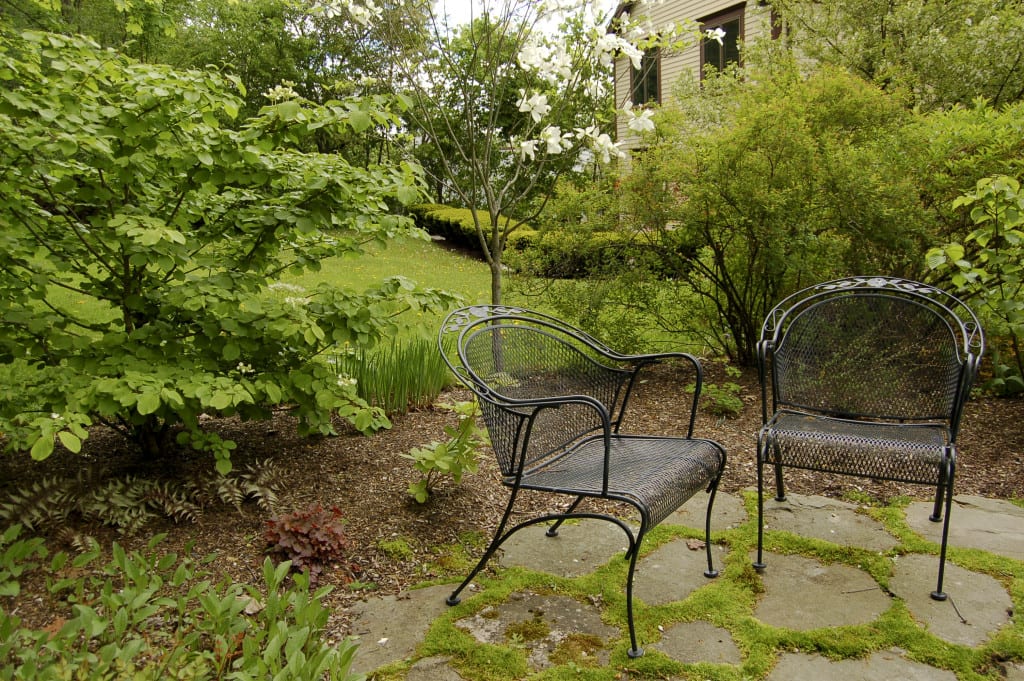
This long-time maintenance client eliminated 100% of her lawn in favor of diverse native plantings and a series of outdoor rooms. Design: Barbara Popolow; Installation: A Yard & A Half; Photo: Jesse Edsell-Vetter.
The good news is that after ten years of providing only organic landscape services, many of our prospective clients now seek us out specifically for ecological landscaping.[1] The public is increasingly aware of the potential harm caused by common landscaping practices of the late 20th century, such as reliance on synthetic chemicals, stripping away organic material, and extensive use of impervious paving.[2] Yet, in spite of increased public awareness, most of us still encounter prospective clients who are unfamiliar with the benefits of ecological landscaping.
As a firm committed to ecologically sensitive landscape construction and organic maintenance, we still sometimes find ourselves in bid situations against “conventional” landscape contractors. The designers with whom we work also face challenges of selling the value of sustainable methods and materials, as well as advocating for their preferred installers who adhere to ecological specifications. Sales guru Zig Ziglar said, “Every sale has five basic obstacles: no need, no money, no hurry, no desire, no trust.” With a prospective client for whom ecological health is not already a deeply held value, how do we overcome these inevitable objections? Like any good sales process, making the case for ecological landscapes requires educating clients, creating emotional connections, and setting realistic expectations.
Educating Clients
The first step in making the case for ecological landscapes is to be clear that we are not just selling a pretty yard. Whether we are selling design, installation, or maintenance, comparing our services (or prices!) to those offered by a conventional firm is comparing apples to oranges. Ecological landscapes are not just gardens. They are investments in resilience; an insurance policy for the landscape and the earth.
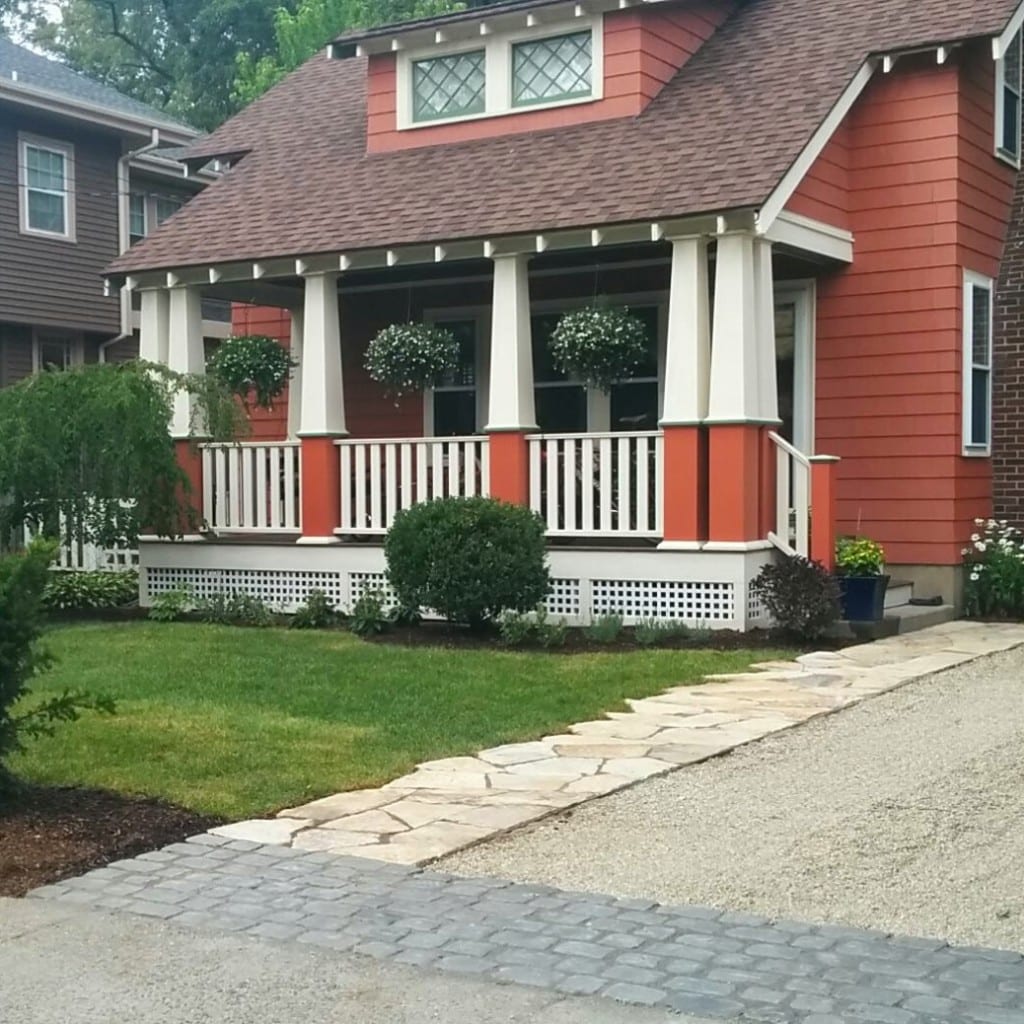
Peastone and dry-laid quartzite steppers allow water from this driveway and walk to stay onside and reenter the aquifer, rather than running off into the street. Photo: Carolyn Edsell-Vetter.
Climate change has brought us colder, snowier winters and warmer summers, increased weed and insect activity, extremes of rain and drought, flooding, runoff, and topsoil loss. In reaction, the regulatory environment is also becoming stricter, with watering and pesticide bans, limitations on impervious surfaces to fight urban runoff, restrictions on the use of gas-powered blowers, and complex permitting for work near wetlands and riparian buffers. As ecological landscaping professionals, we have the knowledge to work with changing natural systems and regulations, developing sustainable landscapes that require minimal inputs and generate minimal waste. Often, the speed of change can help us to create a sense of urgency in our clients, as they struggle amid the vagaries of climate and local politics.
Ideally, we have made the case for ecological landscapes before the client even contacts us, through blog posts, articles for local papers, and promotion of ELA’s fantastic brochure, Discover Ecological Landscaping. Then, when we meet with a prospective client, we can focus on listening and asking questions, rather than telling and selling. “It sounds like you want a large area of hardscape as space for entertaining. Have you considered any permeable paving options, in case the recent addition that you built limits how much impervious paved area you can add to your lot?” As the prospects list their desires (patio, driveway, colorful flower garden), our questions can help expose needs that might be addressed by an ecological approach, as well as demonstrate how we can be a professional partner to meet those needs.
Creating Emotional Connections
Many of our clients feel alienated from both nature and community. Though they may not be able to articulate it in their list of top ten wishes for their landscape, they yearn for connection. Questions about entertaining, the number and ages of children, and where and how they greet neighbors often uncover the desire for human engagement. From there, we can paint a picture of the ecological landscape as a means to draw the client outside to spend quality time experiencing nature with loved ones.
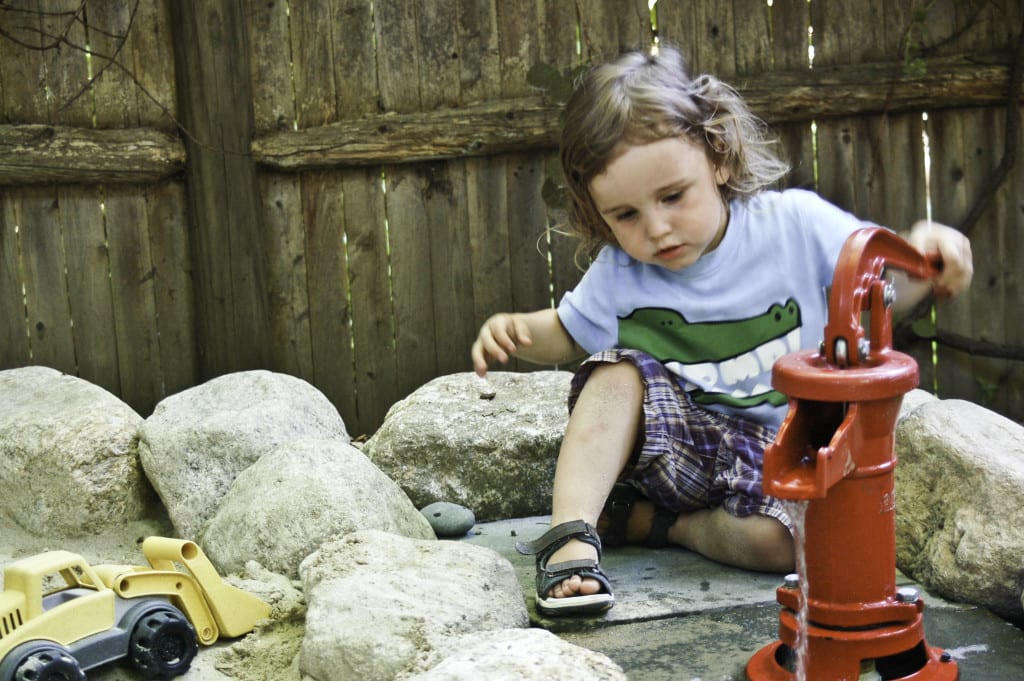
Repeating materials used elsewhere in the landscape, an environmental play area with sand, water, and a working pitcher pump becomes a design feature, addressing the client’s concern about play equipment cluttering their tiny new yard. Shallow pooling water, cool spaced between rocks, and nearby vines are also parts of the backyard’s habitat value. Photo: Jesse Edsell-Vetter.
The National Wildlife Federation’s Certified Backyard Habitat program is an accessible way for homeowners to start to see the potential for their yard to become a place for the whole family to enjoy wildlife, as well as a valuable part of the larger ecosystem. Once clients learn about the concept of regenerative landscapes, there is an innate “feel-good factor” to being part of healing nature. This positive “be a co-creator with Mother Nature” message has a much stronger emotional pull than the negative “don’t kill stuff” message that we well-meaning environmental advocates sometimes use.
Setting Realistic Expectations
Ecological landscaping is a long-term approach, and sometimes the greatest obstacle can be the timeframe. Often, the financial return on investment (ROI) cannot be appreciated for several years. Dense plantings grow in over time, reducing maintenance costs for watering and weeding. The monetary value of a rainwater harvesting system may not become apparent until a watering ban takes effect or water prices rise. Topdressing with compost and using organic fertilizers may be more expensive in the short term, but eliminates the need for additional inputs as turf becomes more resistant to pests, drought, and weeds.
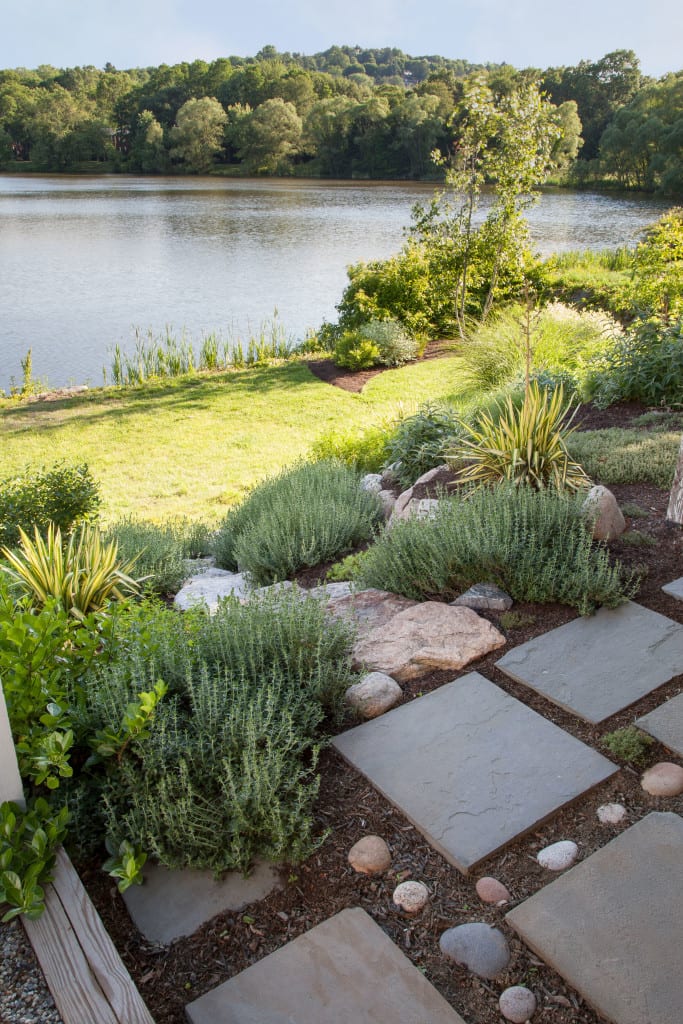
Densely planted, xeric slope and dry-laid stonework terraces slow down water and prevent runoff to the nearby pond. Design: Christie Dustman & Co., Installation: A Yard & A Half Landscaping Cooperative; Photo: Lynne Damianos.
Traditional financial ROI calculations fall short when we are talking about caring for our planet, however. Making the case for ecological landscaping requires practitioners to talk about the triple bottom-line: People, Planet, Profit. For some of our clients, and maybe even for some of our businesses, saving money may be a key goal. But just as we can demonstrate the long-term value of doing the right thing environmentally, we should be frank with our clients about the cost and value of doing the right thing by our people. I have observed that most of us in ELA hire talented, committed people, and we pay wages higher than the industry standard, both because they are worth it and because we want them to be able to support their families. Hopefully, we are classifying these folks as employees, covering them under worker’s comp and unemployment, and providing benefits. As a worker-owned cooperative, when we have this conversation with prospective clients, they generally appreciate that our willingness to invest in a living wage, benefits, and education translates to excellence in the field, long-term relationships, and high quality.
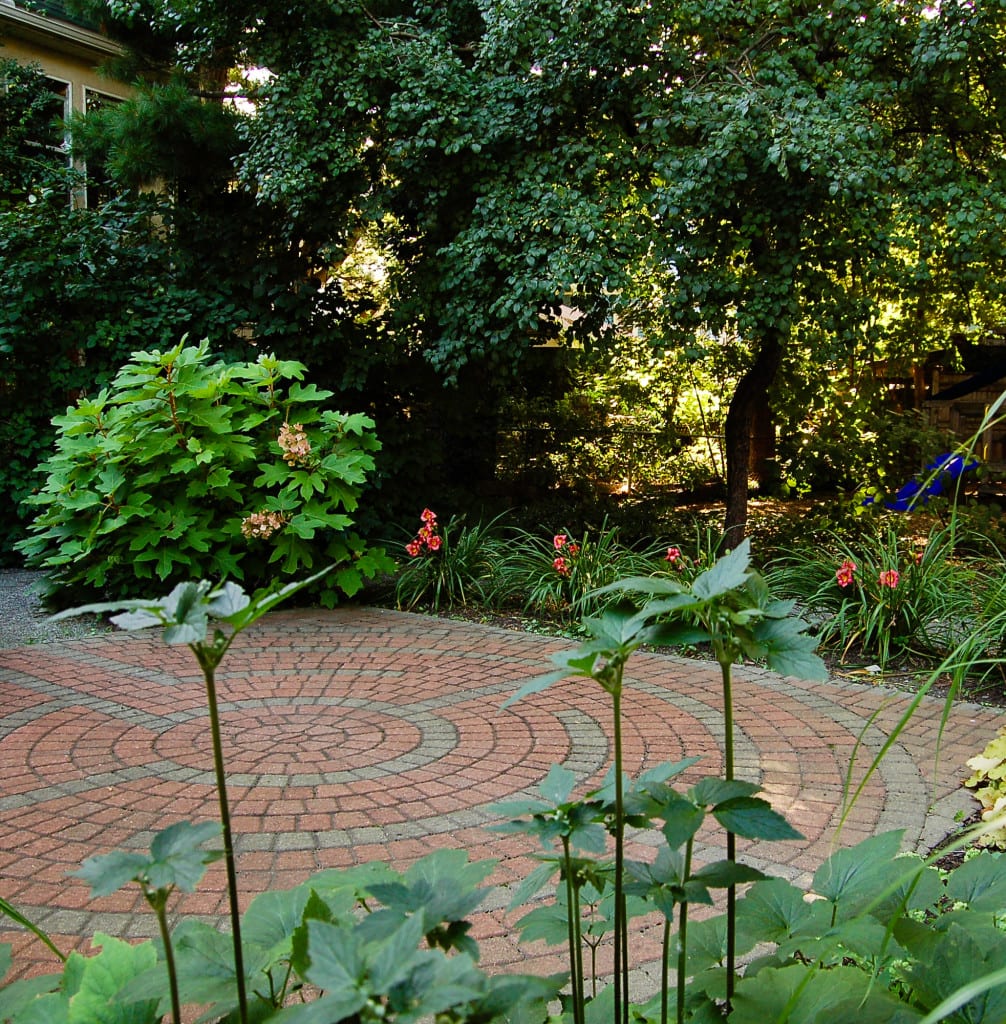
Low-maintenance planting, wheelchair-accessible stonedust walkways and raised beds, and a walking labyrinth create sacred space on the shady lot of an urban congregation. Design & Installation: A Yard & A Half; Photo: Jesse Edsell-Vetter.
All of us in ELA are offering something special to our clients. We owe it to ourselves and to them to take the time to educate them about why our services are different, and when and how they can expect to see a payoff:
“The objectives of an ecological landscaper are to reduce water consumption, preserve water quality, prevent soil erosion, protect biodiversity, diminish the use of toxic pesticides, and minimize the use of non-renewable resources. By striving toward these goals, the ecological landscaper can create gardens that are both environmentally responsible and enjoyable to experience.” – ELA Discover Ecological Landscaping brochure
The tangible end result may be the same as with any conventional landscaper: a beautiful and enjoyable yard. The means, however, are varied and site-specific, and they produce many secondary benefits that conventional landscaping does not: healthy soil, air and water; resilience to changing and extreme conditions; diverse plant and animal life; and productive interconnection with plants, animals, and people.
[1] Although I am speaking from the experience of myself and my co-owners, I think most of us in the ecological landscaping business face similar challenges. Unless I make specific reference to A Yard & A Half, “we” and “our” in this article refer to “many of us in ELA.”
[2] I use the term “conventional” (often used in discussions of organic landcare) throughout the article as shorthand for the late 20th century approach described here.
About the Author
Carolyn Edsell-Vetter, M.Div, MCH, AOLCP, is co-CEO of A Yard & A Half Landscaping Cooperative in Waltham, MA. She joined the company in 2000, and in 2013 led its transition to an employee-owned cooperative. Today, Carolyn is focused on the business operations of A Yard & A Half. She loves to work with team members to develop both their horticultural skills and their “soft skills” for business ownership and career advancement. Carolyn can be reached at Carolyn@ayardandahalf.com.

